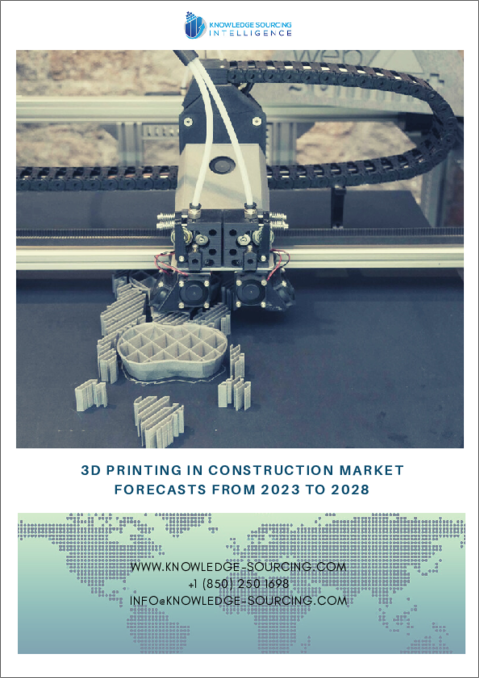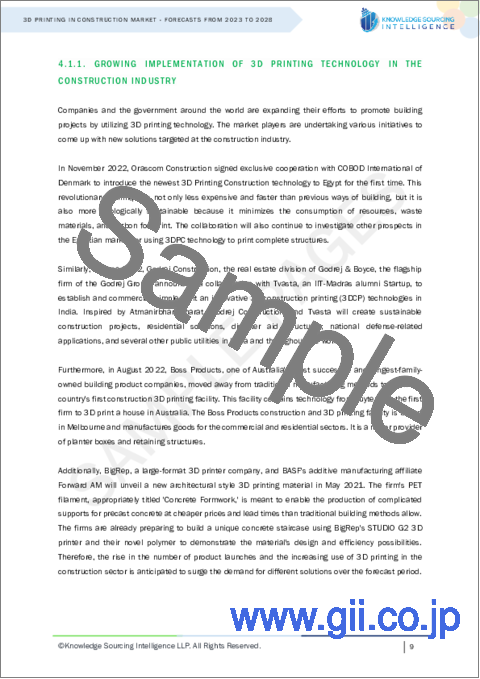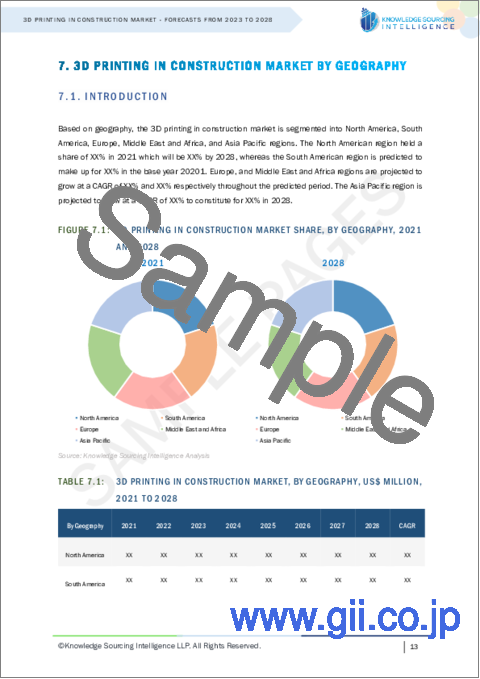|
|
市場調査レポート
商品コード
1087146
建設業界における3D印刷市場:世界市場予測(2022年~2027年)3D Printing in Construction Market - Forecasts from 2022 to 2027 |
||||||
|
● お客様のご希望に応じて、既存データの加工や未掲載情報(例:国別セグメント)の追加などの対応が可能です。 詳細はお問い合わせください。 |
|||||||
| 建設業界における3D印刷市場:世界市場予測(2022年~2027年) |
|
出版日: 2022年05月17日
発行: Knowledge Sourcing Intelligence
ページ情報: 英文 110 Pages
納期: 即日から翌営業日
|
- 全表示
- 概要
- 目次
世界の建設業界における3D印刷の市場規模は、2020年に3,689万3,000米ドルとなり、予測期間中に89.17%のCAGRで拡大し、2027年に31億9,851万5,000米ドルになると予測されています。同市場を牽引する要因には、プロトタイピングとデザインの増加、精度の向上、製造コストの低減などが挙げられます。
当レポートでは、建設業界における3D印刷の世界市場を調査し、市場規模や予測、市場の促進要因および課題、市場動向、セグメント別の市場分析、競合情勢、主要企業のプロファイルなどの体系的な情報を提供しています。
目次
第1章 イントロダクション
- 市場の定義
- 市場セグメンテーション
第2章 調査手法
- 調査データ
- 仮定
第3章 エグゼクティブサマリー
- 調査のハイライト
第4章 市場力学
- 市場促進要因
- 市場抑制要因
- ポーターのファイブフォース分析
- 供給企業の交渉力
- 買い手の交渉力
- 代替品の脅威
- 新規参入者の脅威
- 競争企業間の敵対関係
- 業界のバリューチェーン分析
第5章 建設業界における3D印刷市場:コンポーネント別
- イントロダクション
- ハードウェア
- ソフトウェア
- サービス
第6章 建設業界における3D印刷市場:提供別
- イントロダクション
- プリンター
- パーツとアドオン
- 材料
- その他
第7章 建設業界における3D印刷市場:地域別
- イントロダクション
- 北米
- 米国
- カナダ
- メキシコ
- 南米
- ブラジル
- アルゼンチン
- その他
- 欧州
- ドイツ
- フランス
- 英国
- スペイン
- その他
- 中東とアフリカ
- サウジアラビア
- アラブ首長国連邦
- イスラエル
- その他
- アジア太平洋地域
- 中国
- インド
- 韓国
- 台湾
- タイ
- インドネシア
- 日本
- その他
第8章 競合情勢と分析
- 主要企業と戦略分析
- 新興企業と市場の有利性
- 合併、買収、合意、およびコラボレーション
- ベンダー競争力マトリックス
第9章 企業プロファイル
- Yingchuang Building Technique(Shanghai)Co., Ltd. (Winsun)
- XtreeE
- apis cor
- CyBe Construction
- Sika Group
- PERI
- Rohaco
- Imprimere AG
The 3D printing in construction market was valued at US$36.893 million in 2020 and is expected to grow at a CAGR of 89.17% over the forecast period to reach a market size of US$3,198.515 million by 2027. The construction industry can utilize 3D printing to manufacture construction components or build entire buildings using modeling software. 3D printing is becoming more and more popular for manufacturing complex building structures. BIM (Building Information Modelling) has recently emerged as an efficient means of converting digital models into tangible ones. Using 3D printing technology increases accuracy and efficiency, reduces labor costs, and increases construction speed. A growing market for 3D printers in the construction industry is being driven by increased prototyping and design, coupled with increased accuracy and lower manufacturing costs. Green construction projects are driving market growth due to the increased adoption of the technology. To reduce construction costs and build more energy-efficient buildings, construction companies adopt 3D printing and other green construction methods. The term "green construction" refers to the use of sustainable construction techniques and materials in constructing buildings without causing adverse environmental impacts. According to the World Green Building Trends Survey 2018, approximately 47% of the businesses surveyed expect to apply green technology to about 60% of their construction projects by 2021.
In addition to this, governments are promoting innovation through improvements in public infrastructure and legislation that can be used to increase the adoption of 3D printing. Thus, the increasing government support for 3D printing is creating more market growth. Additionally, sustainable construction practices, the demand for affordable housing solutions, and the growth in the construction sector in emerging countries will drive the market's growth over the coming five years. The LEED system is the most commonly utilised sustainability grading system in the world, with over 1.85 million square feet of new construction certified every day.
Growth Factors:
- Growing demand for infrastructure
Construction 3D printing may reduce labor costs as well as produce less waste and allow for the creation of bespoke or complex items more rapidly and more accurately. Additionally, it may be possible to do construction in harsh environments where humans will be of little use, such as in space. With the growing demand for furniture, bridges, and infrastructure made from materials like metals, plastics, and composites, 3D printing technology has significantly boosted the market growth. It is anticipated that the segment's growth will be driven by companies' efforts to build 3D printed bridges around the world. For example, Weber Beamix and BAM construction firms in the Netherlands are constructing a pedestrian bridge using 3D-printed concrete in April 2021. Approximately 29.5 m will be the length of the concrete bridge. In addition, Weber Beamix will construct 4 more 3D-printed bridges throughout the country. In European countries like the United Kingdom, 3D printing construction companies are increasingly utilizing 3D printing technology for construction, thus driving growth in the region. As an example, in May 2020, Skanska, a company that designs construction infrastructure, announced its collaboration with Loughborough University in the U.K. Together, they will have the purpose of accelerating the use of 3D printing technology in construction in the U.K. An additional reason for moving to custom 3D-printed buildings is its rapid construction speed. For instance, Mighty Buildings, based in California, for instance, now can print an entire unit within 24 hours. When 3D printing can be performed at such speeds, emergency shelters can be created quickly to meet the need for housing and meet the growing housing shortage. In addition to WASP, Mario Cucinella Architects also tests alternatives to concrete for 3D printing. Their recent project, TECLA, was printed in clay in Italy, clearing the way for sustainable long-term 3D printing. The industry is experiencing strong growth which, indicates the market will continue to grow.
Restrain:
- Engineering complexity and lack of regulation
There is no set of rules or process for getting 3D printed buildings approved for residential or commercial use. First, public safety codes, electrical codes, plumbing codes, and structural codes will have to be established by the government. Further, 3D-printed buildings have not really gained an audience among architects or engineers. During the design phase, the new technology's additional capabilities aren't being utilized. Also, the traditional blueprint process cannot be used with 3D printers, so the entire process needs to be reworked. Concrete and plastics are pretty much the only materials the printer head can deliver. The printer may not be able to create wooden or steel components for buildings. All of the above factors pose a threat to the market.
The Impact of COVID-19 on 3D Printing in the Construction Market
Lockdowns and restrictions imposed by countries to contain COVID-19 have disrupted worldwide supply chains and affected the state-of-the-art 3D printing building construction industry. As a result of the shutdown of facilities and restrictions on movement, the production of 3D printing machines and the supply of construction materials used to build 3D structures were impacted. Globally, residential and commercial construction declined sharply during the lockdown imposed by governments. Sales of new houses declined significantly as construction slowed and customers stayed indoors. As reported by the United States Census Bureau, the number of new privately-owned houses sold in February 2020 decreased to 717,000, in March 2020 to 619,000, and in April 2020 to 623,000. The 3D printing building construction market is l negatively impacted by a decline in demand.
Market Segmentation:
- By Component
Hardware
Software
Services
- By Offering
Printer
Parts and Addons
Material
Others
- By Geography
North America
- USA
- Canada
- Mexico
South America
- Brazil
- Argentina
- Others
Europe
- Germany
- France
- United Kingdom
- Spain
- Others
Middle East and Africa
- Saudi Arabia
- UAE
- Israel
- Others
Asia Pacific
- China
- India
- South Korea
- Taiwan
- Thailand
- Indonesia
- Japan
- Others
TABLE OF CONTENTS
1. INTRODUCTION
- 1.1. Market Definition
- 1.2. Market Segmentation
2. RESEARCH METHODOLOGY
- 2.1. Research Data
- 2.2. Assumptions
3. EXECUTIVE SUMMARY
- 3.1. Research Highlights
4. MARKET DYNAMICS
- 4.1. Market Drivers
- 4.2. Market Restraints
- 4.3. Porter's Five Forces Analysis
- 4.3.1. Bargaining Power of Suppliers
- 4.3.2. Bargaining Powers of Buyers
- 4.3.3. Threat of Substitutes
- 4.3.4. Threat of New Entrants
- 4.3.5. Competitive Rivalry in Industry
- 4.4. Industry Value Chain Analysis
5. 3D PRINTING IN CONSTRUCTION MARKET, BY COMPONENT
- 5.1. Introduction
- 5.2. Hardware
- 5.3. Software
- 5.4. Services
6. 3D PRINTING IN CONSTRUCTION MARKET, BY OFFERING
- 6.1. Introduction
- 6.2. Printer
- 6.3. Parts and Addons
- 6.4. Material
- 6.5. Others
7. 3D PRINTING IN CONSTRUCTION MARKET, BY GEOGRAPHY
- 7.1. Introduction
- 7.2. North America
- 7.2.1. United States
- 7.2.2. Canada
- 7.2.3. Mexico
- 7.3. South America
- 7.3.1. Brazil
- 7.3.2. Argentina
- 7.3.3. Others
- 7.4. Europe
- 7.4.1. Germany
- 7.4.2. France
- 7.4.3. United Kingdom
- 7.4.4. Spain
- 7.4.5. Others
- 7.5. Middle East and Africa
- 7.5.1. Saudi Arabia
- 7.5.2. UAE
- 7.5.3. Israel
- 7.5.4. Others
- 7.6. Asia Pacific
- 7.6.1. China
- 7.6.2. India
- 7.6.3. South Korea
- 7.6.4. Taiwan
- 7.6.5. Thailand
- 7.6.6. Indonesia
- 7.6.7. Japan
- 7.6.8. Others
8. COMPETITIVE ENVIRONMENT AND ANALYSIS
- 8.1. Major Players and Strategy Analysis
- 8.2. Emerging Players and Market Lucrativeness
- 8.3. Mergers, Acquisition, Agreements, and Collaborations
- 8.4. Vendor Competitiveness Matrix
9. COMPANY PROFILES
- 9.1. Yingchuang Building Technique (Shanghai) Co., Ltd. (Winsun)
- 9.2. XtreeE
- 9.3. apis cor
- 9.4. CyBe Construction
- 9.5. Sika Group
- 9.6. PERI
- 9.7. Rohaco
- 9.8. Imprimere AG




